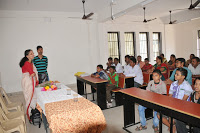
We flew in Thursday night (Nov. 14) to Bhubaneswar. I love Bhubaneswar. It’s small, colorful, intriguing, and poor. Paved roads give way to dirt roads; cars give way to bull-drawn carts. Sometimes it seems the poorer the place, the more intrigued and comfortable I am. If I dared to believe in reincarnation, as Hindus do, I’d say I must have come from the slums in an earlier life. I am at home in them, and am drawn to them.
The hotel is nice that we checked into last night. Clean, quiet. But no hot shower, again. Will I never have a hot shower in India? This time it’s because the water heater was “hidden” from view—my own fault. The food in the restaurant is also good. Indian food is just delicious!
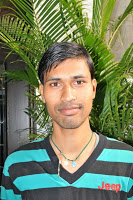
Usha and I again pack up toys and factor to share, and Chittaranjan, the secretary for the Bhubaneswar chapter, picks us up at 8:30 am. We go to the medical college where Chitta is attending as a nursing student.
Chitta is an amazing young man. Only 24, but so unworldly mature. He has hemophilia, limited access to any factor, is going to college, doing well, and running a whole hemophilia chapter! He pulled together this entire event today. His demeanor is respectful, but he knows when to push to get an idea or suggestion across. I marvel at his diplomatic communication skills. This young man is a keeper.
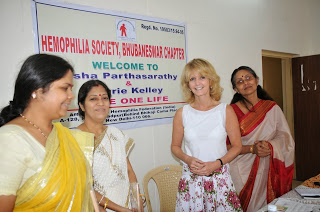
The event was lovely. A large sign welcoming us personally was hung on the wall. A special plaque was given to us both thank us for our help. So many families had traveled from very far away, to see us. We got to meet them all, one by one, and ask some questions related to their lives.
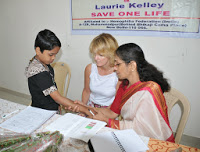
For example, one, Jitendra, is 14 years old. He receives money from Save One Life and spends it on education and treatment. He lives 150 kilometers away. His father works on a farm, and must travel far away daily. The father had an intense countenance, a combination of fear and desperation.
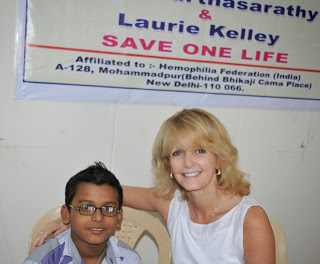
When I asked him what one thing would make your life easier (expecting him to say free factor) he said emphatically and without hesitation: a vegetable selling business, to open a roadside vendorship, to be near his son. Awesome answer. He needs 50,000 rupees to start ($1,000). Through out chat we learned that a storm ruined his house and he now lives in a tent!! He only earns $100 a month. We stressed to our partners that they must inform us when disaster strikes our beneficiaries! We can help this man, and I promise him we will get this money for his business.
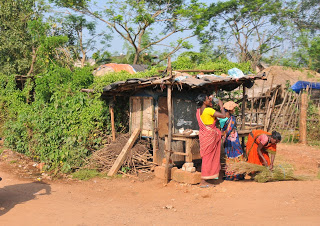 We took photos with each child, recorded their progress and needs. The dean of the medical college came in to meet us, and greet the children. After a few hours, a take-away lunch was served, and we set out to do some home visits. One obstacle to our work is language: communication is really confusing here. India has about 70 languages, so when we travel to different cities, we have to speak English, translated into Hindi, translated into the local language and then back again. So three people are needed to ask questions and translate! When 2-3 people are speaking simultaneously, explaining, talking over each other, questions and answers are easily misunderstood. We must be über careful when interviewing so correct information is taken. Some things are almost a given and are never misconstrued: most families earn about $10- $40 a month, nothing when you think of what they have to buy. And add hemophilia on top of this… life is a day to day struggle to survive.
We took photos with each child, recorded their progress and needs. The dean of the medical college came in to meet us, and greet the children. After a few hours, a take-away lunch was served, and we set out to do some home visits. One obstacle to our work is language: communication is really confusing here. India has about 70 languages, so when we travel to different cities, we have to speak English, translated into Hindi, translated into the local language and then back again. So three people are needed to ask questions and translate! When 2-3 people are speaking simultaneously, explaining, talking over each other, questions and answers are easily misunderstood. We must be über careful when interviewing so correct information is taken. Some things are almost a given and are never misconstrued: most families earn about $10- $40 a month, nothing when you think of what they have to buy. And add hemophilia on top of this… life is a day to day struggle to survive.
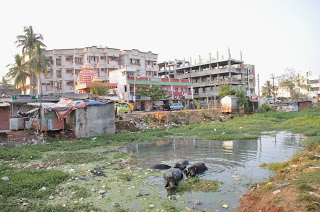
This is one reason why education is paramount. When you meet a child in the States, you often ask, “How old are you?” In India, you must ask, “What class are you?” Education trumps anything else in their young lives. Education is a key to a future. This is one reason why we stress that Save One Life monies be considered for funding education costs.
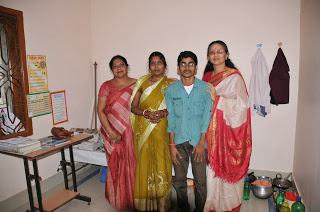
We head out eventually to visit Bikram, a young man who is sponsored by Save One Life but who needs a scholarship. He desperately wants to attend medical college and needs funding to study for one year, called “medical coaching,” so he can pass the exams to get in. Bikram lives in a clean, new building, but he and his parents live in one small room of this. There is nowhere to cook. There is no bathroom, just a public one down the hall and out a door. There’s one bed and you must use your imagination to sort out where do they all sleep? Bikram never smiles the entire time we visit. I compliment him on the colorful motivational charts I see on the wall. Set goals. Listen to directions. Believe in yourself.
I tell Bikram we will get him the $1,000 he needs for coaching. Somehow. Believe in us. The mother has tears in her eyes when we explain to her we will help. She offers us some simple food, in the customs of Indians when you come to their home. It is always startling humbling when you are in the homes of the poor, sometimes the poorest of the poor, and they exhibit more graciousness than just about anyone you know.
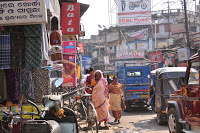
On Friday morning, we head to Cuttack, a suburb of Bhubaneswar, about an hour away. It’s a very colorful ride, past temples, roadside vendors, and fruit stands. The streets are a mad scramble packed with cows, bicycles, motorbikes, autorickshaws, trucks and cars. The hospital is a public one, so it is exploding with people. Chitta, Usha and I have to shoulder by a crowd to get in to the hematology ward.
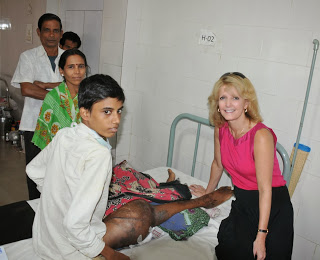
Our goal was simply to say hello to the director of hematology. He has so many people waiting in line we feel guilty being ushered in. We chat a bit, snap some photos, and then head out to the wards. While at the wards, we come across a huge and shocking surprise. A 16 year old boy, Deepak Das, propped up in a sad bed, flanked by his worried parents. His right thigh is grotesquely swollen, causing his right foot to drop; the skin is stretched till it looks like it might explode. It’s a pseudotumor, Dr. Sudha explains, and he needs an amputation ASAP. This is a complicated case and we urge the staff to consider bringing him to an HTC. They have no factor to do the operation and the operation has been postponed but the boy is now critical. We pledge the factor and any money that can help. The mother starts to cry, and the father immediately sets to praying intensely. India’s culture does not include hugging in public, but this mother, so grateful leans into me and we hug.
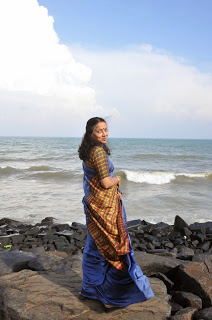
Our last city is Pondicherry, in the south, a short drive from Chennai. We flew to Chennai for two days to attend the 25th anniversary celebration of the Chapter, where Usha is from. She is delighted to be home. But Sunday morning, back on the road with a two hour drive to Pondi. Pondicherry is a former French colony which still retains a French flair about it. It’s pretty and quite different than the rest of India. It has temples, museums and a botanical garden (you know this if you watched Life of Pi). It seems to me there are however more stray dogs here than anywhere else. India is ravaged by stray dogs much as the dogs themselves are ravaged by fleas, ticks and skin disease —ubiquitous, yellow mutts with the mandatory
curly tail, as though they were all sired at one time by a common set of parents. Half are lame; many are lactating. They are starved, wary and are everywhere. They set their eyes on me, Usha says, because they know I look different and they are hoping for better treatment from a foreigner. They do tend to approach me and follow me.
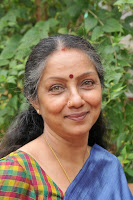
We meet with a large group of children at the clinic, and do a home visit in the evening. on Monday, my last day in India, we go to the beach with Dr. Nalini, who runs the clinic and the chapter. Usha and I stand at the Bay of Bengal, enjoying the fresh sea breeze and watching the European tourists. We take in an ashram, where people go to study yoga, and best of all, an ancient 15 century Hindu temple. We removed our shoes, and walk in gingerly, speaking in hushed tones. I witnesses how Hindus pray; their unusual gods, with elephant and monkey heads, blue faced, adorning the walls. I joined a line to enter a sacred room, where everyone was praying. An oil lamp was brought out by a half-naked Indian, and devotees waved their hands in the flame, then touched power to their heads.
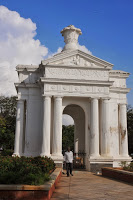
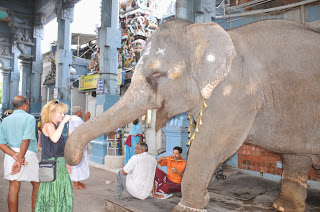
Exiting, I was surprised by an enormous pewter-colored elephant, ornamentally painted and sporting an ankle bracelet, just outside the temple door. When you offer it a coin, it snatches it then touches your head in blessing. Not having any rupees, I think I gave it a New York City transit coin.
We were tired after the day; the weather was steamy and humid. We drove back to Chennai, straight to the airport, after saying our good byes to Nalini. We stopped at a roadside place that was good, and ate some Northern Indian food and masala tea, summing up our to-do list for the week. I was kind of happy to be back in my traveling clothes—black pants, white sleeveless hiking top—but sad to leave. On this my fourth trip, I am used to India now, comfortable. I never get sick, and love the food and people. I do get mentally drained trying to sort out the languages, cadences and interruptions, but am ridiculously pleased overall with how Save One Life programs are functioning and are actually making a concrete measurable difference in patients’ lives.
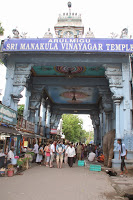
Back towards Chennai and the city was crazy bustling at night. Thousands of roadside vendors, shops, motorcycles, autorickshaws. It’s a sensory overload. I am in awe at the amount of humanity in one city. And yet the airport was all but empty, giving Usha and me the time and space to say a bittersweet good bye. We are great partners, and compatible traveling mates. I guess it all seems easy when you have one mission, one goal. Much to think about on a 24-hour ride back to my world.
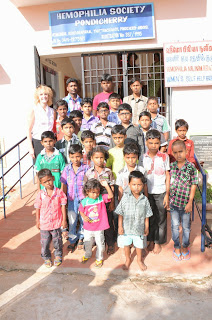
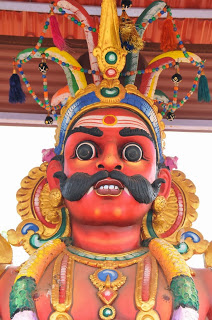
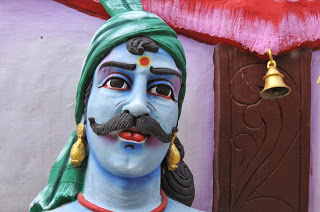


2 thoughts on “Believe in Us: Bhubaneswar and Pondicherry”
I wanted to thank you and Ms. Usha for the amazing work. And I want/wish a miracle to happen for the lovely boy Deepak.
Pondicherry is most popular tourist attractions in India. This city is popularly called as peaceful Pondicherry and little France. This city is well renowned for its French lifestyle and architectures. Here are some popular tourist places in Pondicherry compiled by the weekend leader.